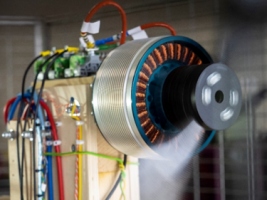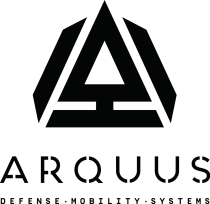Clean Sky 2 research project LiBAT demonstrates the propulsion performance of its exceptional AC battery system

December 2020 - In the last months, the LiBAT consortium has successfully tested its highly innovative AC battery system, demonstrating a power performance that is sufficient to maintain level flight for a manned glider.
The lightweight, compact, and highly-integrated battery rotated an electric motor with propeller attached in a lab setting. The advanced LiBAT technology can be applied to a broad range of applications in the transport sectors, taking us a large step towards a more sustainable future.
When we talk about the need for cleaner transport – be it in the air, on the street or anywhere else – electrified mobility is currently in the focus. But state-of-the-art batteries are still relatively heavy, posing a serious obstacle for the breakthrough of electrically propelled aviation.
This is where the EU-funded Clean Sky 2 project LiBAT takes off. The high power and high energy battery system designed in LiBAT provides AC electric current in a concise system with low weight.
Connected to an electric propulsion unit, the prototype battery that was built in LiBAT demonstrated powers of up to 3,25 kW in a lab setting – enough to maintain level flight for the targeted aircraft application, an electrified glider. With the identified design improvements, take-off will be feasible as well.
The potentially game-changing LiBAT battery system solution addresses the weight problem by an extraordinary level of integration and a combination of advanced technologies. By integrating multi-level-inverter technology into the battery, the LiBAT team created a unique, tuneable AC battery system that eliminates the need for additional charging or motoring power electronics and saves extra weight.
Combined with a powerful immersive thermal management and a suitable cell choice, both excellent energy and power performance are realized, given the low weight and volume of the pack. The modular design guarantees a scalable system. With an energy density of 200Wh/kg and 3C continuous discharge currents, the design meets the ambitious projects targets.
LiBAT demonstration in Garching. The LiBAT battery powers an electric motor with propeller attached. Powers of up to 3,25kW with currents up to 30 A peak value have been achieved at 2860 rpm in the tests.
The research was conducted by the German companies TWT GmbH and LION Smart GmbH within the Clean Sky 2 program, funded by the European Union through the Horizon 2020 initiative.
Project coordinator TWT GmbH specializes on innovative development services across various industries and will bring LiBAT insights to its customers. The company’s engineering team contributed to the design and verification, and performed electrothermal system simulations in an early stage to predict performance and improve the design.
TWT’s in-depth simulation expertise pushed the project progress early and provided a profound insight into the dynamics of the LiBAT battery. LION Smart GmbH is an engineering company that specializes in research and development of innovative battery solutions in the field of e-mobility.
The company’s team was pivotal in system design, prototyping and testing of the battery pack. “Designing and testing a battery system for aviation purposes was both challenging and exciting due to the special safety and weight requirements. Development of a custom testing lab was crucial to reach and surpass the specific power and RPM requirements needed to maintain level flight in an aircraft this size. We were able to contribute much of our company expertise in the areas of thermal management, battery management systems, and battery pack design; but also gain new knowledge for the implementation of future projects”, said Julia Eckhardt, the LiBAT Project Manager for LION Smart.
“The integration of multi-level-inverters into the battery as we have done on the LiBAT project is a solution known within the research sector. However, we have taken the bold step of applying it to mobility applications. We are confident that this game-changing technology will transform the battery systems sector for mobile applications.”, Prof. Paul Riley of City University London states. Together with Dr Obrad Dordevic, an expert for power electronics and control from Liverpool John Moores University, they supplied the power electronics technology for the battery pack.
Dr. Dordevic was also in charge for testing of the converter and for the overall control of the system operating in various modes – propulsion as well as charging. “With increased number of levels, the control complexity is also increased. It was exciting seeing all the theory working in practice. Special challenge on this project was that all tests have been done remotely, due to COVID-19 restrictions to travel. It was a pleasure doing all tests with people from LION Smart team.”, Dr Obrad Dordevic from LJMU said.
Applications for the LiBAT battery can be found in many fields, especially for electric air taxis, hybrid propulsion systems, flexible frequency auxiliary networks, electric and hybrid cars, as well as power tools. It is very suitable for electrified gliders, which were the focus of this research project.
Dassault Aviation was topic manager and set very ambitious goals for the project. The LiBAT demonstrator is most likely the highest-powered device of its kind in the world. It is also a milestone on the Clean Sky 2 Work Programme regarding battery energy density and a breakthrough in the power density of multifunctional power electronics.
Like many other research projects, LiBAT met several challenging situations during a COVID-19-affected year that culminated in a short-term location change for the final integration tests. “We are glad that the EU gave us the possibilities to build this extraordinary battery system and supported us along the way. With the immense complications of the pandemic we are all extremely happy and proud to see the battery power the motor today.”, Dr Jan Dahlhaus, the project coordinator, said at the final demonstration in Garching.4e4






